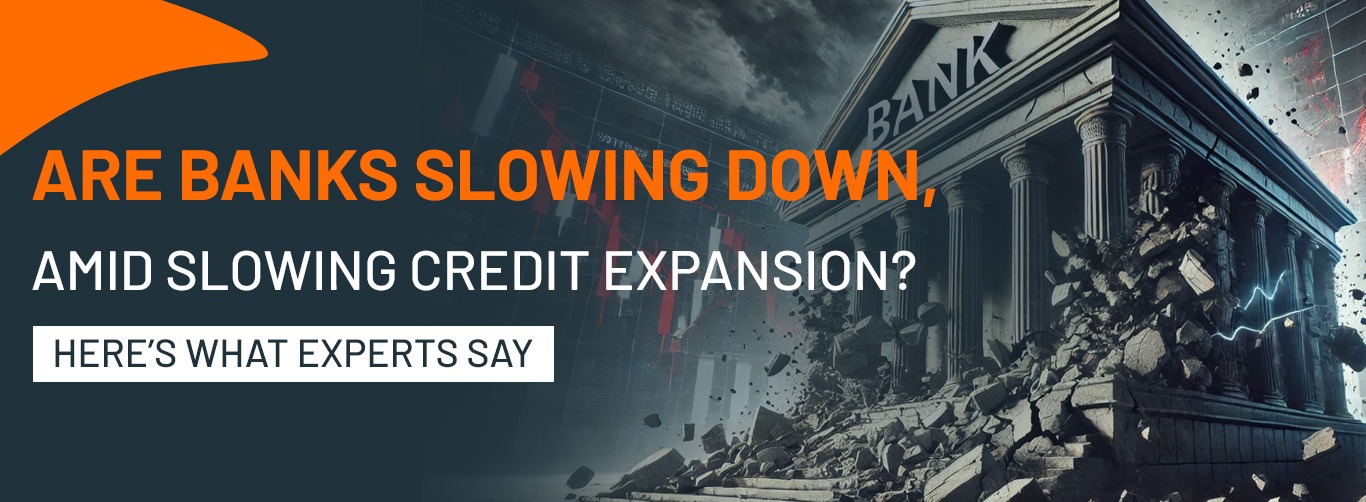The Indian banking sector has been one of the market’s bright spots in recent quarters, consistently outperforming broader indices. While the Nifty has slipped over 6% year-to-date (YTD), the Bank Nifty is down just 2%, showing relative resilience.
But beneath this outperformance lies a more nuanced story—credit growth is clearly losing steam.
With multiple headwinds converging—from regulatory tightening to macroeconomic caution—the critical question now is: Are Indian banks entering a slowdown phase? And if so, is it a temporary breather or the start of a longer trend?
Let’s break it down.
Slower Loan Growth: A Growing Concern
Bank credit growth, which once galloped in the 14–16% range, has cooled sharply. As of February 2025, year-on-year credit growth stood at 10.9%, down significantly from 16.6% (ex-HDFC merger) and 20.6% (incl. merger) in February 2024.
The deceleration is widespread:
- Personal loans growth halved to 8.4% from nearly 20% last year.
- Credit card loan growth plunged to 11.2% from 31% a year ago.
- Loans to NBFCs and the services sector also slowed dramatically.
- Industry loans saw tepid growth at 7.3% YoY, down from 8.4%.
The slowdown isn’t surprising. In late 2023, the RBI tightened norms for unsecured lending, requiring banks to hold more capital against risky assets like personal loans and credit card debt. The result? Banks pulled back sharply from aggressive lending, especially in the retail segment.
Deposit Growth Keeps Pace, But CD Ratio Remains Elevated
Interestingly, deposit growth has largely kept pace with credit growth. As of Feb 2025, deposits were up 10% YoY, almost matching the growth in loans. However, the credit-deposit (CD) ratio—a key metric that shows how much of the deposits are being lent—remains high at over 80%.
Some banks are actively working to lower this ratio. For instance:
- HDFC Bank’s CD ratio improved to 97% in March from 101% in September 2024, reflecting a deliberate focus on liability management.
- The bank’s deposit growth (14% YoY) outpaced its loan growth (5.4% YoY), a rare but telling shift.
The Outlier: Gold Loans Buck the Trend
While most loan segments are cooling, gold loans have surged—up a whopping 87.4% YoY in February. This growth stems from:
- Reclassification of agri-gold loans to retail gold loans (which have higher credit limits).
- A sharp 37% rise in gold prices, making gold-backed lending more attractive for both banks and borrowers.
Banks like CSB Bank, with a strong gold loan portfolio, reported 30% YoY loan growth, showing how this niche segment has become a major driver amid otherwise tepid credit conditions.
What Does This Mean for Bank Earnings?
Despite slower credit expansion, bank earnings have held up, so far.
- Asset quality remains benign in most segments, except for microfinance and unsecured credit, which are showing some stress.
- Net Interest Margins (NIMs) are expected to shrink in coming quarters, especially after the RBI’s February 2025 rate cut.
- However, lower credit costs and better operating efficiency may cushion the impact on profits.
That said, most analysts agree that banking sector profitability has peaked, and the FY26 outlook will hinge on margin management and cost discipline.
The Regulatory Tailwind: A Silver Lining
There is good news, though. The RBI, under Governor Sanjay Malhotra, has signaled a more supportive stance:
- 25 bps rate cut in April 2025 (with more expected).
- Liquidity infusion through OMOs, VRR auctions, and dollar swaps.
- Postponement of stricter regulations on LCR norms and project finance provisioning.
- Relaxation of risk weights for microfinance and NBFC loans.
These steps suggest a regulatory pivot to stimulate lending and ease liquidity, which could pave the way for a rebound in credit growth later this year.
What Do Experts Say?
Market analysts widely believe that the recent slowdown in loan growth was largely anticipated following the Reserve Bank of India’s regulatory tightening in late 2023.
The measures, especially higher capital requirements for unsecured lending, prompted banks to recalibrate their risk strategies and focus on improving credit quality and deposit traction.
Experts also point to a meaningful policy shift by the RBI in early 2025, including liquidity infusion measures and the first rate cut in several quarters.
These steps are seen as early signs of a more accommodative stance aimed at reviving lending momentum and supporting broader economic activity.
According to research firms and brokerage houses, large private sector banks such as HDFC Bank, ICICI Bank, and Kotak Mahindra Bank are expected to weather the transition better than smaller peers, owing to their stronger balance sheets, robust liability franchises, and better digital ecosystems.
Conclusion
The Indian banking sector is clearly in a phase of moderation—not distress. Slower credit growth is a natural correction after years of rapid retail lending and aggressive expansion.
While near-term pressures on margins and growth may persist, strong asset quality, improving deposit traction, and supportive regulatory policies offer a cushion. If the macroeconomic environment stabilizes and RBI’s rate cuts spur demand, banks could very well resume their growth journey in the second half of FY26.
Until then, the sector may be cooling—but it’s far from cold.
Disclaimer: This article is for informational purposes only and should not be considered as investment advice.

Leave a Reply